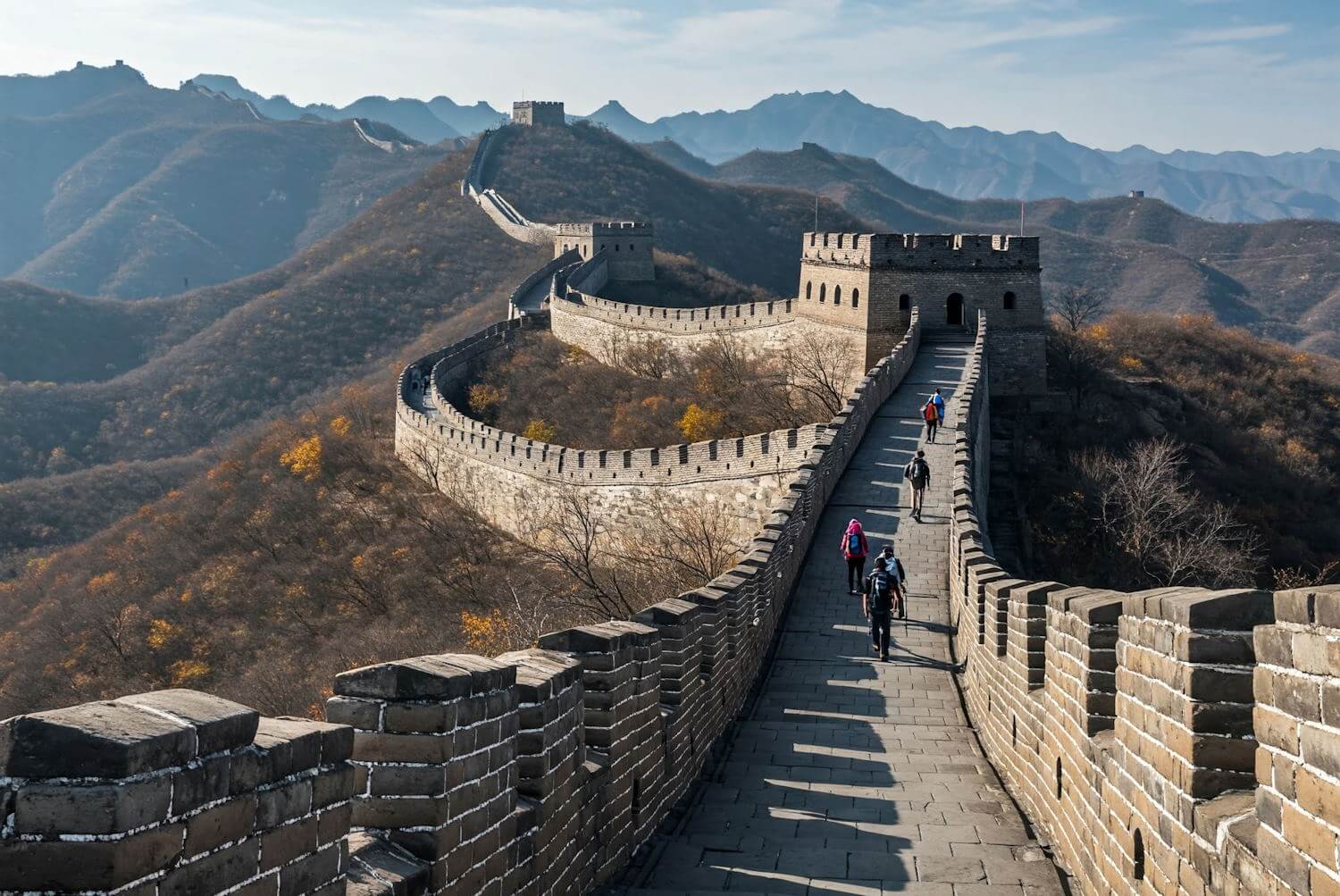Introduction to the Great Wall of China
The Great Wall of China stands as a monumental testament to the nation’s historical resilience and architectural ingenuity. Spanning approximately 13,170 miles, this ancient fortification meanders across diverse landscapes, ranging from rugged mountains to expansive deserts, showcasing the geographic expanse of China. Its construction began as early as the 7th century BC, with several dynasties contributing to its expansion and fortification over the centuries, primarily aiming to safeguard against invasions from northern tribes.
The most notable contributions came during the Ming Dynasty (1368-1644), when the wall was extensively rebuilt and fortified, resulting in the structure that many visitors recognize today. This period marked a resurgence in construction techniques, leading to the incorporation of bricks and stone, which improved the durability of the wall. In contrast to earlier methods that relied on tamped earth, the Ming advancements have allowed a significant portion of the wall to endure for centuries, inviting both admiration and study.
Additionally, the Great Wall was not solely a defensive mechanism; it served multiple purposes throughout its history, including functioning as a psychological barrier designed to discourage invasions, as well as a means of imposing tariffs and regulating trade along the Silk Road. Beyond its military roles, the wall became a powerful symbol of strength and unity for the Chinese people, embodying their rich cultural heritage and historical narrative.
Today, the Great Wall of China attracts millions of tourists annually, each eager to walk along its storied paths and immerse themselves in a piece of history that reflects the trials, triumphs, and the enduring spirit of a civilization that has thrived for millennia. As visitors traverse its length, they encounter not only a remarkable engineering feat but also the collective memory of a nation’s journey through time.
Preparing for the Trek
Embarking on a trek along the Great Wall of China requires careful planning and preparation to ensure a rewarding and safe experience. One of the first considerations is timing. The best periods to visit the Great Wall are typically in the spring (April to June) and autumn (September to November). During these seasons, the weather is mild, and the landscape is particularly scenic, making it an ideal time for hiking. Summer can be hot and crowded, while winter may bring harsh weather conditions that could hinder travel.
Appropriate gear and equipment are crucial for a successful trek. At a minimum, trekkers should wear comfortable, sturdy hiking boots that provide ample support for uneven terrain. Clothing should be moisture-wicking and layered to account for changing temperatures throughout the day. Essential accessories include a good-quality backpack, a reusable water bottle (to stay hydrated), and sunscreen to protect against sun exposure. Furthermore, a map or guidebook of the specific section of the Wall being trekked can enhance navigation and understanding of the historical context.
Physical fitness is equally important when preparing for this adventure. Although some sections of the Great Wall are more accessible than others, many parts involve steep ascents and rugged paths that can be physically demanding. It is recommended that individuals engage in a conditioning program that includes cardiovascular exercises, strength training, and flexibility routines to build endurance and prevent injury during the hike.
Lastly, thorough research on the various sections of the Great Wall is essential. Different areas, such as Badaling, Mutianyu, and Jinshanling, offer distinct experiences ranging from well-preserved tourist sites to remote and rugged pathways. Understanding the specific characteristics of these sections will help trekkers select a route that aligns with their interests and abilities, contributing to a memorable journey along this remarkable historical monument.
Choosing Your Trek Route
When planning a trek along the Great Wall of China, one key consideration is the selection of the route that best aligns with your preferences and abilities. The Wall, stretching over 13,000 miles, features numerous sections, each offering unique characteristics and challenges. Among the most popular and easily accessible routes are Badaling, Mutianyu, Jinshanling, and Simatai, each with its own appeal.
Badaling is often regarded as the most famous section and attracts thousands of visitors yearly. It has been entirely restored and provides a well-maintained path, making it suitable for trekkers of all skill levels. The breathtaking views from this section reveal the grandeur of the Wall snaking through the mountains, but it can feel crowded during peak seasons.
In contrast, Mutianyu offers a balance between accessibility and scenic beauty. This section features a mix of restored and original stone pathways, creating an authentic trekking experience. Furthermore, the panoramic vistas are particularly stunning during autumn when foliage transforms into vibrant hues. The cable car service available here also adds convenience for those looking to minimize walking distance.
For those seeking a more adventurous trek, Jinshanling and Simatai are ideal choices. These sections are less frequented and are known for their rugged terrain and impressive watchtowers, preserving a sense of historic charm. Jinshanling features steep ascents and descents, making it more challenging, while Simatai offers dramatic scenery and nighttime tours that illuminate the Wall, providing a unique perspective.
Ultimately, the choice of route will depend on personal preferences regarding difficulty, scenery, and historical significance. Each section of the Great Wall presents an opportunity not only to conquer physical challenges but also to embrace the rich history that this monument embodies.
What to Expect During the Trek
The Great Wall of China is not merely a monument of history; it is a transformative experience for those who embark on the trek along its ancient path. Trekking the Great Wall presents a myriad of terrains, ranging from well-preserved stone sections to rugged, overgrown areas that offer both challenge and beauty. The wall snakes through various landscapes, including steep mountains, serene valleys, and picturesque countryside, each offering a unique perspective of this remarkable structure.
Weather conditions can vary significantly depending on the season. Spring and autumn are often considered the best times to trek, as temperatures tend to be mild and skies clear, making for a comfortable walking experience. However, trekkers should be prepared for sudden changes in weather, particularly in mountainous regions where conditions can shift rapidly. Winter brings a different kind of charm, with snow-covered sections providing a tranquil and ethereal atmosphere, while summer can be hot and humid, requiring ample hydration and sun protection.
Throughout the trek, the scenery is nothing short of breathtaking. Travelers can expect to behold sweeping vistas that encompass rolling hills, dense forests, and even glimpses of rural life in nearby villages. Each segment of the wall reveals its own distinctive character, from crumbling watchtowers that tell tales of the past to vibrant wildflowers dotting the pathways. As trekkers navigate these diverse terrains, they may also have the opportunity to engage with locals along the way. Whether sharing a moment with a farmer tending to their crops or enjoying a chat with fellow hikers, these interactions enrich the overall experience, providing insights into the local culture and way of life.
The Great Wall trek offers an unforgettable journey that encapsulates a sense of historical significance, stunning natural beauty, and cultural connectivity, making it a must-do for adventure seekers and history enthusiasts alike.
Historical Highlights Along the Trek
The Great Wall of China, an architectural marvel, extends majestically across diverse landscapes, offering numerous historical sites that enrich the trekking experience. Among these, the watchtowers are particularly significant. Constructed primarily during the Ming Dynasty, these structures served multiple purposes, including military communication and surveillance. As trekkers navigate along the wall, they will encounter the iconic watchtowers, such as the famous Jiankou and Huanghuacheng towers. Each one tells a unique story of the strategic military planning employed to defend against invasions, allowing trekkers to connect with China’s robust history.
In addition to watchtowers, various fortresses and beacon towers dot the landscape, each representing different periods of construction and significance. The imposing fortresses, like the one at Shanhaiguan, are strategic entry points that mark the beginning of the Great Wall where it meets the sea. Historical events, such as the battles that took place nearby, add depth to the trek. For example, trekkers at the Badaling section can reflect on how this area was pivotal during significant military confrontations, providing a tangible link to the past.
Furthermore, remnants of various dynasties that contributed to the Wall’s expansion showcase the evolution of Chinese defensive architecture. The trek also encompasses sections that highlight the cultural exchanges that occurred along these routes. The transformation from military fortification to a symbol of unity allows trekkers a unique perspective on the Wall’s broader impact on Chinese heritage. Walking along the Great Wall is not merely an adventure; it is a profound journey through the annals of history, making each step resonate with significance.
Local Culture and Cuisine
The Great Wall of China is not only a marvel of architecture but also a gateway to the rich local culture and diverse cuisine that characterizes the surrounding regions. As trekkers journey along its ancient paths, they encounter vibrant communities shaped by the proximity to this UNESCO World Heritage site. These villages and towns reflect the historical significance of the wall, where customs and traditions have evolved over centuries, deeply intertwined with the structure itself.
Culinary experiences in regions near the Great Wall present a gastronomic celebration of traditional Chinese cuisine. Travelers can indulge in iconic dishes such as Peking duck, which is a celebrated delicacy originating from Beijing, and various regional specialties such as lamb skewers and dumplings. These offerings not only provide a taste of local flavor but also tell stories of the area’s agricultural heritage, with ingredients sourced from the surrounding fields and mountains. Street food markets often feature seasonal produce, giving visitors the chance to enjoy freshly prepared meals as they explore the landscapes.
Moreover, cultural customs are prevalent in the communities adjoining the Great Wall. Festivals and local celebrations, such as the Mid-Autumn Festival and the Dragon Boat Festival, provide visitors with opportunities to witness traditional performances, engage with local artisans, and participate in age-old practices. The influence of the Great Wall on local lifestyles is evident through the preservation of craftsmanship, such as wall-building techniques that locals have honed over the years. This interplay of history and modern living creates a unique cultural experience that enriches the trekking adventure.
Travelers are encouraged to interact with local residents, whose stories illuminate the significance of the Great Wall in their daily lives. Engaging with the culture through cuisine helps deepen one’s appreciation for the heritage that continues to thrive in the shadow of this monumental structure.
Tips for a Safe and Enjoyable Trek
Embarking on a trek along the Great Wall of China offers not just a chance to appreciate stunning vistas but also an opportunity to engage with history. To ensure your experience is both safe and enjoyable, several practical tips should be considered.
First and foremost, proper hydration is crucial. The physical demand of trekking can easily lead to dehydration. Carry sufficient water, ideally at least two liters per day, and consider portable water filtration systems if you plan to refill from natural sources. Additionally, be mindful of the drinking water quality, especially in remote areas where accessibility may pose challenges.
Next, sun protection is essential when trekking under the open sky of the Great Wall. Use broad-spectrum sunscreen with a high SPF, and apply it regularly, especially if you sweat considerably. Wearing a wide-brimmed hat and UV protective clothing can also shield you from harmful rays, allowing you to enjoy the trek without the risk of sunburn.
As you navigate the rustic paths of the Wall, it’s important to remain cautious of uneven terrain. Wear sturdy hiking boots with good ankle support to prevent slips and falls. Trekking poles can also provide stability, especially on the more rugged sections where steep ascents and descents are common.
Altitude sickness may affect some trekkers, particularly in elevated sections. Gradually acclimatizing to higher altitudes and listening to your body’s signals will help manage this risk. If you experience dizziness or nausea, descending to lower elevations is advisable.
Lastly, consider local customs and regulations during your trek. The Great Wall is not only a historical monument but also a cultural one. Respect the environment by adhering to designated paths and disposing of waste responsibly. Engaging positively with local communities enhances the experience for both trekkers and residents, ensuring that the Great Wall remains a treasured site for future visitors.
Capturing Memories: Photography on the Great Wall
Trekking along the Great Wall of China offers not only breathtaking views but also a remarkable opportunity for photography enthusiasts to capture stunning memories. To make the most of your photographic experience, it is essential to consider the optimal time for your shots, the right techniques for composition, and the most scenic locations along the wall.
The golden hours of photography typically occur during early morning and late afternoon. During these times, the light is soft and warm, casting long shadows and enhancing the textures of the wall and its surroundings. Additionally, dawn provides a serene atmosphere, often allowing for spectacular fog effects that can lend a mystical quality to your images. Conversely, late afternoon light can create a stunning contrast against the rugged terrain, making it an ideal time to capture vibrant colors and striking landscapes.
When composing your shots, consider employing the rule of thirds; this technique encourages placing points of interest off-center, resulting in dynamic and engaging photographs. Furthermore, incorporate leading lines to guide the viewer’s eye along the wall, allowing for a sense of depth and perspective. Don’t shy away from experimenting with various angles—candid moments of fellow trekkers or panoramic views can yield unique and memorable results.
As you journey along the Great Wall, keep an eye out for particularly picturesque spots. The watchtowers, often placed strategically throughout the wall, provide excellent vantage points for wide shots of the landscape, plus interesting architectural elements. Some noteworthy sections include Jinshanling and Mutianyu, renowned for their well-preserved structures and breathtaking backdrop. Capturing these iconic images will tell a story, reflecting both the beauty and history of this remarkable monument.
Conclusion: The Legacy of the Great Wall Trek
The Great Wall of China represents not only an astounding architectural achievement but also a significant chapter in the rich tapestry of human history. As trekkers navigate its uneven paths, they are offered an unparalleled opportunity to connect with the past, immersing themselves in the echoes of ancient civilizations and the stories that have shaped China’s identity.
Walking along the Great Wall allows individuals to witness the remarkable engineering feat that extends across deserts, mountains, and plains, illustrating the lengths to which past societies went to protect and strengthen their kingdoms. Each step taken on this monumental structure serves as a reminder of the resilience and determination of those who constructed it. The trek provides an intimate experience, enabling travelers to engage with historians, local guides, and fellow hikers, each sharing unique insights that enrich the journey.
Moreover, the importance of preserving the Great Wall extends beyond its immediate physical structure. This world heritage site symbolizes cultural identity and national pride for the Chinese people, while also offering global travelers a glimpse into the historical context of one of the world’s most recognizable landmarks. As communities worldwide face challenges from modernization and environmental deterioration, the need to maintain and protect such legacies becomes increasingly evident.
As we reflect on the experiences gained from trekking the Great Wall of China, it becomes clear that this adventure is not merely about conquering miles of stone and earth, but rather about understanding the profound impact this iconic monument has on our collective history. Therefore, we encourage readers to consider embarking on their own journey, embracing the transformative power of history that lies within the walls of the Great Wall of China.




